This post is part of a draft on South Siberian language homelands and Sprachbünde.
The following text contains a description of Yeniseian languages, their dialectal groupings and likely evolution among surrounding ethnolinguistic groups before they were first documented. Special emphasis is placed on ancient Yeniseic formants for water bodies, widely distributed through Western, Southern, and Central Siberia. Finally, the archaeological-archaeogenetic discussion is focused on Early Bronze Age Glazkovo-related and Okunevo-like cultures, due to their patrilineal connection to sampled Yeniseian and ancient Na-Dene populations.
PLEASE NOTE. Many of the Y-SNP calls from ancient samples referred to below have been analyzed by the FamilyTreeDNA Haplotree team formed by phylogeneticist Michael Sager and Göran Runfeldt from the R&D team. Those ancient samples with validated haplogroup inferences are marked by a hyperlink to the FTDNA Haplotree. Occasionally, though, such hyperlinks are also used in the text when discussing Y-SNP branches in general, without referring to specific ancient samples. For a quick reference of ancient samples, you can check out the Ancient DNA Dataset, also visually in an Online Web Map, in SNP Tracker, or in AncientDNA.info. TMRCA and formation dates have been checked from YFull.
1. Yeniseian languages
Siberia’s once widespread Yeniseian language family probably predates the expansion of reindeer breeders and earlier pastoralists in North and Inner Asia (Dul’zon 1959, 1962, Vajda 2001, 2009, Werner 2005). The Ket language, almost extinct, is the only language of the Yeniseian family that survived into the 21st century. Most Yeniseian-speaking tribes (Arin, Assan, Baikot, Kott, Pumpokol, Yarin, Yastin) used to live south of the current Ket settlements, many of which were forcefully established in the 1930s during the Soviet rule.
The Yeniseian languages are first mentioned in a c. 1600 tsarist yasak or fur tax collection (see map below), and are documented from the 18th and 19th century. They can be divided into Ket-Yugh, Pumpokol, and Assan-Kott branches, with Arin either connected with Pumpokol or Ket-Yugh, or representing a fourth sub-branch. Today the Yeniseian language family is represented only by the three surviving dialects of Ket.
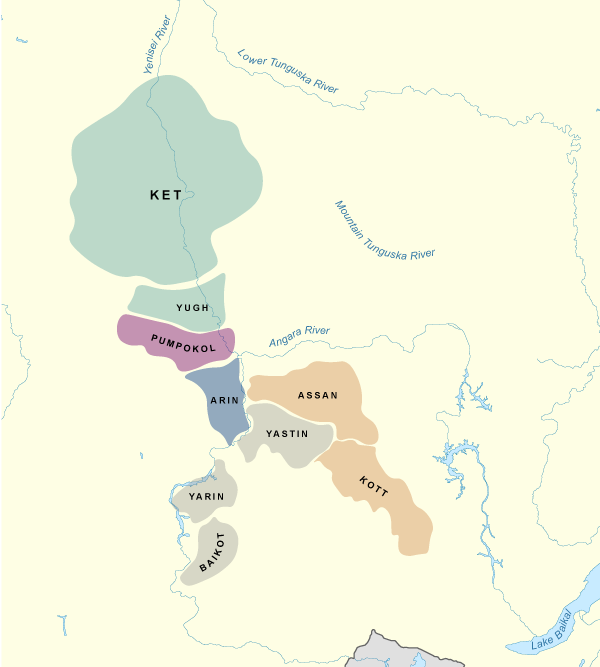
All attested dialects appear related to a time depth of ca. 2000 years, with the breakup of Common Yeniseian occurring earlier, possibly coinciding with the expansion of Scythians (ca. 700-200 BC). Further dispersal of the Ket-Yugh branch to the north might have been triggered by the Xiongnu (ca. 300 BC – AD 200). If Proto-Yeniseian is dated between 2000 BC and the beginning of our era (cf. Vajda 2019), widespread Para-Yeniseian hydronymy (see below) suggests that a Pre-Proto-Yeniseian language should be dated to an even earlier period (cf. Peyrot 2019).
The potential inclusion of Na-Dene in an expanded Dene-Yeniseian language would be represented by an even earlier Neolithic community, but also to a more restricted homeland area for both, closer to Lake Baikal.
NOTE. To avoid naming conflicts and artificial divisions, I will use below (Common) Yeniseian for the eastern, well known reconstructible branch, and (Proto-)Yeniseic as an umbrella term for Proto-Yeniseian and possible sister Para-Yeniseian branches inferred from hydronymy. In any case, the time estimates for Proto-Yeniseian and Dene-Yeniseian taken together do not allow for great differences between Yeniseic branches closely related with Common Yeniseian.
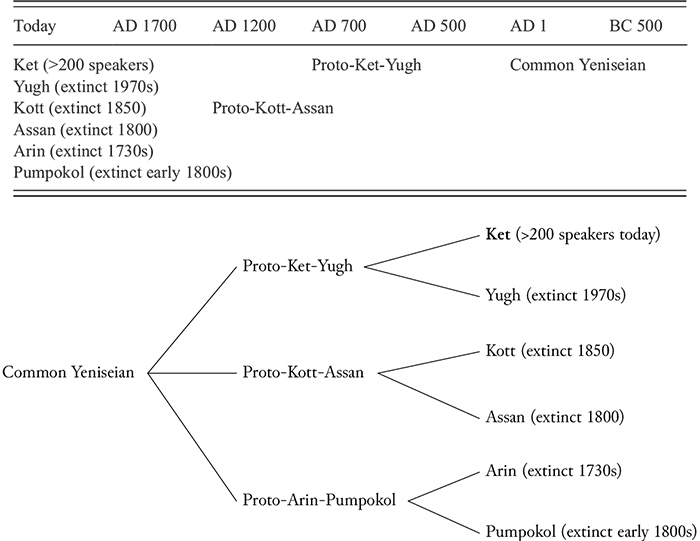
Evolution and Contacts
The Dingling hunter-gatherer tribes along China’s northern border – mentioned in Chinese historiography in the 1st century BC – are arguably the first historically mentioned linguistic forbearers of the Ket (cf. Ket dɛɁŋ ‘people’), according to Vajda (2020). On the other hand, these tribes are considered to have been formed by a majority of Turkic-speaking peoples, due to their incorporation into the Xiongnu Empire and thus likely close relationship with Huns (see below Proto-Turkic Homeland).
Despite the potentially promising identification of some of the few attested Xiongnu words as Yeniseian (Vovin 2000, 2002), the absence of grammatical or phonological influence of the hugely influential Xiongnu or later Huns suggests that these peoples were not primarily speakers of Yeniseian, but rather speakers of suffixal-agglutinating – i.e. “Turkic-Mongolic-like” – languages (Vajda 2020). Some potential Proto-Turkic loans in Yeniseian, with a few only attested in Ket-Yugh, support the proposed chain of Common Yeniseian migrations of hunter-gatherers along the Yenisei during this period, probably pushed by the expanding Xiongnu, rather than represented by them.
Yeniseian shows almost exclusive contacts with Siberian Turkic: the earliest layer stemming from contacts with Yenisei Turkic, but most loanwords belonging to a later layer, corresponding to Altai Turkic. A few early Turkic etyma support the described evolution proper of Common Yeniseian; cf. Kott kulʲuk ‘brave’ ← Turkic *külük ← *kǖlüg, or Kott kajax ~ kajag ‘butter’ ← Turkic *qayaq, cf. OT kańak (Khabtagaeva 2015b). Morover, a small number of these corresponds to intermediate loanwords of Mongolian origin, such as Kott šugur ‘one-eyed’ ← Turkic *sogur ← Mongolic *soqor, or Kott keršo ← Turkic *kärsǟ ← Mongolic *kersegü (Khabtagaeva 2015a). These Mongolic terms were also borrowed into other Eurasian languages (such as *soqor into Tundra Yukaghir soquor ‘blind’, Udmurt sukir ‘blind’ ← Tatar suqâr ‘blind’), which points to their role as possible Wanderwörter in the wider Siberian cultural context (Piispanen 2019).
Modern Yeniseian varieties show what seems like an intricate relatively recent structural hybridization, a typological accomodation of the original Yeniseic prefixing structure to neighbouring Samoyedic and Turkic languages, mimicking their morphological and phonological patterns, not paralleled by grammatical borrowings. This trend seems to have been under way already during the time of Common Yeniseian. For example, the pattern of suffixal agglutination was gradually adopted, but no affixes were borrowed in this process, nor did any change occur in the order or function of the original prefix slots, which took instead simply the appearance of suffixes (Vajda 2020). As another example, the formation of adverbial and relative clauses imitates that of the surrounding (Samoyed, Eastern Khanty) languages, and does not conform to the expected ‘polysynthetic’ pattern (Nefedov 2015).
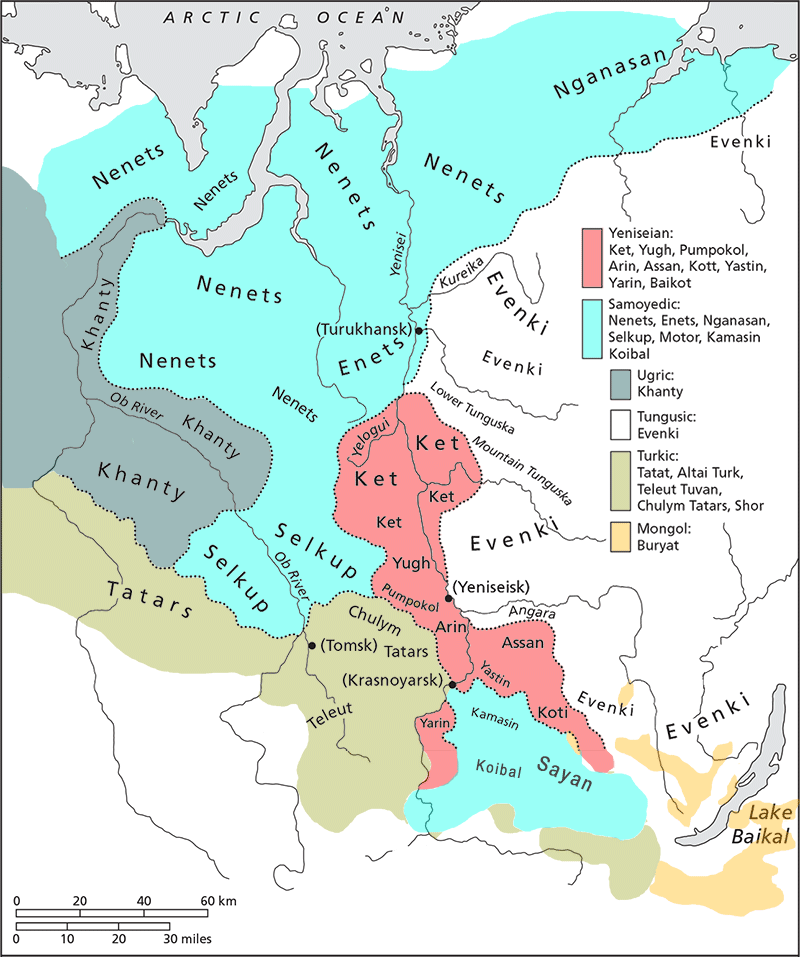
A clear Yeniseian substrate can be discerned in some well-studied Siberian groups. Some South Siberian Turkic dialects, like Chulym, show an evidence substratal Yeniseic layer, whereas ethnic divisions among northern dialects (Northern Altai, Shor, Khakas, Tuvan), and presumably the actual clans they refer to, originate from Yeniseian. The extinct Southern Samoyed Koibal and Karagas are presumed to be acculturated Yenisean speakers due to the many loanwords attested in their scarce documented vocabulary. Furthermore, the Tofa are believed to have arisen from a deeper Yeniseic substrate (Vainshtein 1961), first shifting to Samoyedic, and later to Turkic, with some groups possibly shifting directly from Yeniseic to Turkic (Anderson & Harrison 2020).
NOTE. For a critical view of Yeniseic areal contacts, see e.g. Georg (2008).
Of all their neighbours in the Yenisei River Basin, the Selkup maintained the closest and most friendly relationships with the Ket, often exchanging marriage partners. This is also seen in the words borrowed between the two peoples for family relations and spiritual culture (cf. Kim-Maloney 2004). Also, some Selkup groups show ethnic autonyms borrowed from Yeniseian (see below Proto-Samoyed Homeland). Yeniseians seem to have maintained adversarial relations with their northern neighbours, like the Enets and Nenets, although Janhunen (1986: 167-168) suggests that the glottal stop in Nenets diffused from Ket, with tribal names adopted by Samoyeds along the Lower Yenisei supporting this substratal or adstratal influence.
All Turkic loanwords related to kinship terms – including compounds of assimilated amalgamations, hybrid words, or “half-affixes” (Khabtagaeva 2015c) seem to have been incorporated into the already split-up Yeniseian dialects (Khabtagaeva 2018), suggesting that Yeniseians and Turkic peoples intermarried only recently and variably with neighbouring groups. All Tungusic loanwords discernible in Ket come from Northern Tungusic (Evenki) dialects (Khabtagaeva 2017).
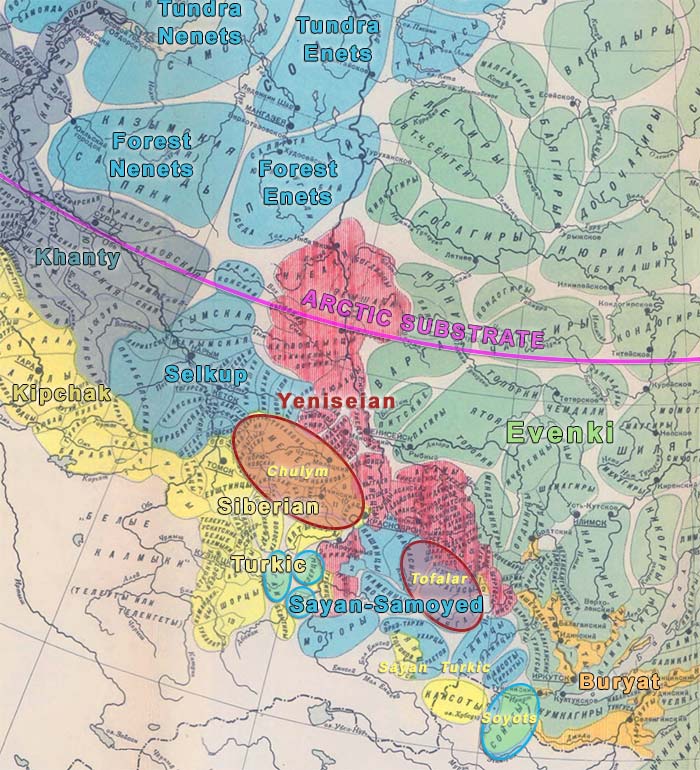
Hydronymy
It is well established based on hydrotoponymic evidence that, prior to the 17th century, speakers of the Yeniseian language family occupied vast territories of Western and Central Siberia, from northern Mongolia in the south to the Middle Yenisei River in the north, and from the Irtysh River in the west to the Angara River in the east (Dul’zon 1959, Maloletko 2000, Vajda 2001).
Known Yeniseian daughter languages are distinguishable in the substrate toponymy around the Yenisei River Basin, which suggests that Common Yeniseian might have already broken up into distinct Ketic, Kottic, Arinicic and Pumpolic daughter branches prior to the arrival of pastoralist tribes to the area, roughly 3000 years ago. However, how much earlier the breakup of Common Yeniseian predates pastoralism in the Siberian forest-steppes and taiga zones is impossible to ascertain (Vajda 2019).
Nevertheless, Vajda (2019) considers the core area containing all Common Yeniseian and other Yeniseic formants to lie to the south, between the Ob and Angara rivers and the Altai-Sayan region, with further dialectal specialization noticed in expansions to the west and north of this area. In fact, river name formants of unknown origin found in sub-Arctic central Siberia – e.g. sɨm or qo’l – support the inferred recent northward expansion of Ket-Yugh.
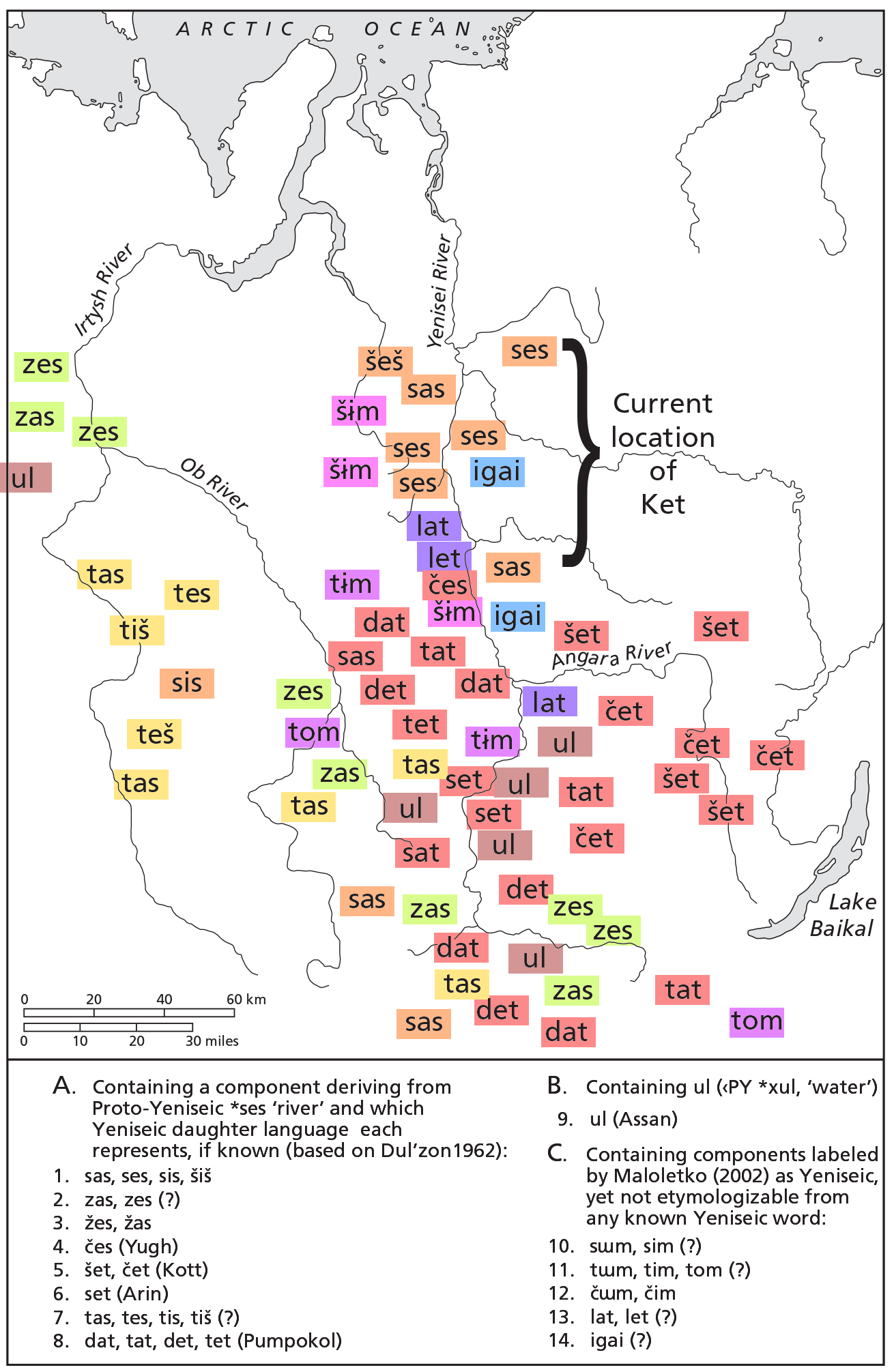
Further, the diversity of Yeniseian substrate river names* across Western, Southern, and Central Siberia strongly suggests that the family originally had considerable internal depth and variation, and that some primary branches vanished unrecorded (Vajda 2020):
* These refer only to hydronyms that contain evident cognates of Common Yeniseian words for ‘river’ or ‘water’, and not to the arguably much more frequently encountered palce and river names of West Siberia which are potentially etymologizable as Yeniseic.
- Hydronyms in tis, tyš, tas, taš – with the best known one being the Irtysh River – indicates the existence of an additional unattested node of Yeniseian.
- River names in zis, zaš, zes indicate yet another.
- Those in tes and ši also do not correlate well with any known Yeniseian language.
- Rivers in kat (or its substrate phonetic variants ket ~ gat ~ get ~ gyt) were convincingly argued by Werner (2012) to stem from a Proto-Yeniseian root meaning ‘clan’ (cf. Ket kə’t ‘children of the same mother’ and Kott kat ‘children’), which – together with formants Kottic šet or Ket ses (cf. PYen. *sēs river) – are presumed to represent “kin groups who nomadized near the given river, and who met and traded there with other nationalities, thus transferring their clan designation to an alien linguistic community as the name of the given river” (Vajda 2019). In fact, their geographical distribution coincide in general terms with the borders of the Yeniseic hydronymic area (see map below).
- Formants in kul have a closer association with Yeniseian (cf. PYen. *xūl the most prevalent word for ‘water’), despite some potential imitation beyond its core area (e.g. with Turkic achi-). Similarly, given their distribution, formants in šet or man (shared with Na-Dene) might have been spread by Turkic groups, despite their non-Turkic origin (although read below about the multilingual Xiongnu in Proto-Turkic Homeland).
- Many Siberian hydronyms in ur (cf. Yugh ūr ‘water’) are difficult to etymologize, and can be described from the Oka to the Amur river basins. Lacking additional evidence of Yeniseians living that far west of the Urals or east of Lake Baikal, it is tentative at best to identify any of them as Yeniseian (Vajda 2019), unless relevant connecting clusters are found with the core hydronymic area.
- Eastern Khanty dialects also contain Yeniseic loanwords, in line with the presence of Yeniseic toponyms in the Ob’-Irtysh watershed.
Recognizable Yeniseic formants are thus present in Western Siberia throughout the Ob’ River Basin – including names along the Vakh, Tym, Vasygan, Ket’, Chulym, and Tom river basins – and Irtysh River Basin – including names from the Tobol, Ishim, Tara, and Om river basins – almost up to the eastern slope of the Ural mountains. Blažek (2015: 72) and Vajda (2019) offer a summary with some of the most reliable hydronyms of the Ob-Irtysh system, including those already described by Duľzon (1959: 98-111) and Maloletko (2000: 111-153).
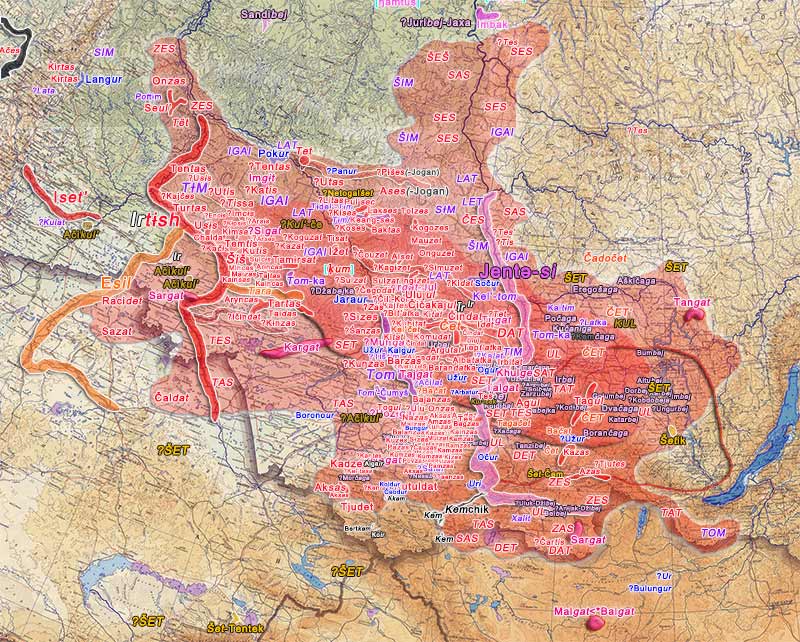
- Wider red area (more transparent) covers main Yeniseian hydronymy from Vajda (2020).
- Red elevated zone includes main Yeniseic hydronymy according to Maloletko (2000).
- Red border with shadowed rim: Core ancestral Cis-Baikal Common Yeniseian area according to Vajda (2019), between the Yenisei and Angara rivers.
- In red, sure Yeniseic hydronyms (with the basin of rivers or tributaries painted over in red, whenever possible). Dubious locations are marked with initial interrogation mark.
- In purple, likely Yeniseic formants without clear Yeniseian etymology.
- In magenta (with elevated painting over the water body), river or lake names of Yeniseic ethnonymic origin in gat/get, kat/ket.
- More questionable Yeniseic formants:
- In blue, names in ur.
- In brown, names in kul potentially spread by non-Yeniseic peoples.
- In orange, names in šet potentially spread by non-Yeniseic peoples.
- In fuchsia, formants in si/ši potentially related to Yeniseic, or to a preexisting Palaeo-Siberian substrate.
- In dark orange, possible Yeniseic water body formants (Blažek 2015).
- In pink, likely Sikhirtya (Sixirtja) hydronyms in -čaga, -bej.
- Within [brackets], ethnonyms based on foreign words (color on the outside represents linguistic group using it, font color represents original language group).
- In black, distribution of a common “Palaeo-Eurasiatic” hydronymic formant, kam-/kem-.
2. Archaeology and population genomics
More than 90% of Kets sampled to date share Q1b-L330 lineages, a proportion much greater than neighbouring Selkups, who show ca. 66-72% of hg. Q1b-L56. This likely east-to-west cline is in line with a diminishing proportion of hg. Q1b in an apparently south-to-north cline that reaches Nganasans in the lower Yenisei, where N1a-P43 predominates (ca. 92%), with different clades of hg. N1a-L708 and downstream N1a-L1026 appearing in west-to-east clines along the Taiga and Tundra (cf. Karmin et al. 2015, Flegontov et al. 2016, Ilumäe et al. 2016, Tambets et al. 2018).
Selkup is known to have been used as lingua franca among tribes inhabiting the northwest of the Yeniseian-speaking area (Anderson 2004), with Kets and Selkups having a long-lasting history of intermarriage. Even more important, Ket villages from the Northern Yenisei were settled in the 19th-20th centuries from mixed populations (Nenets, Evenks, Selkups, Yakuts), which questions the ancestral origin of many of these haplogroups. Similarly, recent migration and/or language shift events resulted in the emergence of Northern Selkup communities (e.g. Poshekhonova, Zubova & Sleptsova 2020) and Russification of southern ones. In fact, it is impossible to say if the distinctive ancestry of Yeniseian and Selkup speakers survives unadmixed today among modern speakers, since present-day Ket speakers are genetically indistinguishable from Selkup speakers (Flegontov et al. 2016).
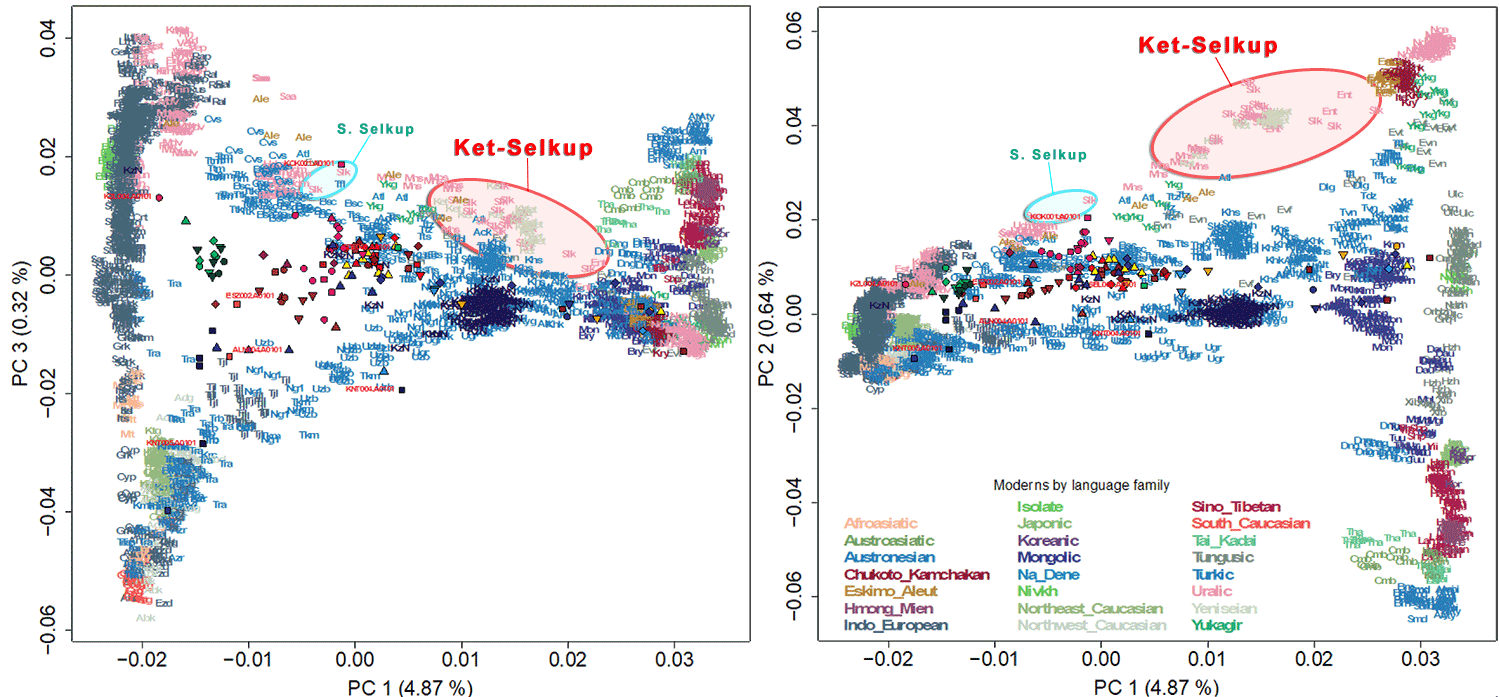
Of note, the ancestry of sampled modern Khants – not only Eastern Khants – and many of the modern Mansis sampled to date forms part of the same wide West Siberian cluster. The different Y-DNA bottlenecks partially shared by Ob-Ugrians and the genome-wide data from elite Sargat nomads published in Gnecchi-Ruscone et al. (2021) suggest that this is the result of convergence through admixture with (and/or acculturation of) a population likely also ancestrally formed by Yeniseic speakers (see below Ob-Ugric Homeland).
In any case, the acculturation of traditionally Yeniseic-speaking territory shifting to Samoyed – and the specific Q1b-L330 found among them (see below Proto-Samoyed Homeland) – supports the historical and linguistic evidence that both modern populations – Selkups and Kets – are reliable proxies for ancient Common Yeniseians, or, alternatively, of more distantly related Yeniseic-speaking peoples that shifted recently to Samoyed (Selkup and Enets) and Common Yeniseian (Ket-Yugh), respectively. Whether other haplogroups (like N1a-Tat subclades) also spread west- and northward with Yeniseic languages through the West Siberian forest-steppes and taiga, is yet unclear.
The main open question about Proto-Yeniseic expansions discussed below is therefore that modern Kets from the Lower Yenisei could in fact represent an earlier Yeniseic layer instead of the Common Yeniseian one, which might have been associated with further migration waves caused later during the MBA by the arrival of Karasuk (first), and by LBA/IA Altai-related expansions. Whether these population movements caused an expansion of Common Yeniseian speakers from Upper Yenisei populations downstream, or rather a renewed Yeniseic splits and expansions from the hypothetical Cis-Baikal – Altai-Sayan – Ob’ core area, and which ones caused which, is unclear, although the lack of recent southern influences in Ket-Yugh suggests that at least part of splitting Common Yeniseian dialects developed already disconnected from Iron Age and later migrations to the south (see Evolution above).
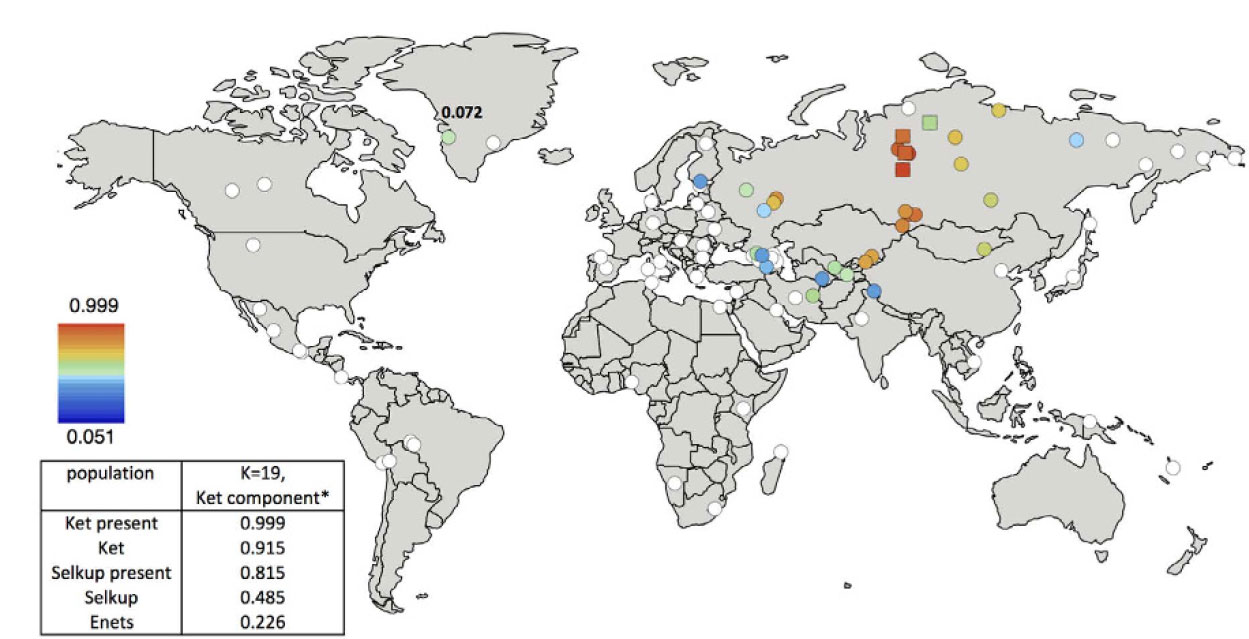
Glazkovo culture
The emergence of the Early Bronze Age Glazkovo culture shows changes relative to the Late Neolithic Serovo complex, represented mainly by the described mortuary traditions: appearance of copper alloy and polished nephrite artifacts, larger Glazkovo cemeteries, new pottery styles, fewer graves with multiple burials, an increase in exotic and labour-intensive objects, different orientations of individuals in graves, and increased heterogeneity in grave good distribution between Glazkovo individuals (Weber 1995, Weber et al. 2002, Weber & Bettinger 2010).
Shepard et al. (2016) has proposed that the change from Serovo to Glazkovo mortuary protocols reflects a change in socio-political organization. Specifically, he suggests that the Serovo political economy emphasized corporate strategies involving local resources while the political economy of the Glazkovo shifted to include network-oriented exclusionary strategies that emphasized status distinctions between individuals. Weber (2020) argues the change is due to the introduction of a new form of socioeconomic organization involving any of the following: new mechanisms of land tenure, new patterns of group formation, expanded exchange networks, and/or lower competition between gender and age groups.
Whatever the case, there is today a general agreement about the presence of non-local individuals in Little Sea EBA-Glazkovo cemeteries. Different scenarios to explain the influx of non-locals include a larger seasonal round, more long-distance ‘macro-regional’ interaction, and/or the prosperity of Little Sea Glazkovo society drawing in individuals from neighbouring groups (Haverkort et al. 2008, Weber & Goriunova 2013, Shepard et al. 2016, Weber 2020).
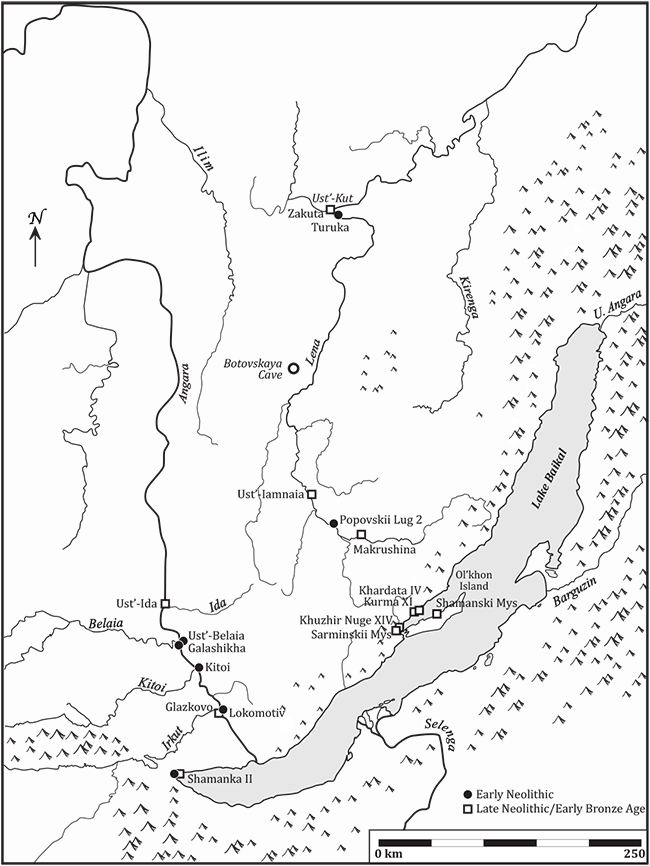
Glazkovo and related sites from the Cis-Baikal region show a certain variability in terms of Y-chromosome haplogroups, but with an overwhelming majority of Q1b lineages (36 out of 41 analyzed), hence similar to preceding populations of the area. Among them, these are some relevant downstream Q1b-L53 subclades reported (cf. Damgaard et al. Science 2018, Flegontov et al. 2019, Yu et al. 2020, Kılınç et al. 2021):
a. Q1b-L53>YP4010>YP3966>YP3955 (formed ca. 15900, TMRCA ca. 5300 BC), found in 24 samples, most if not all of them under Q-BZ2197 (formed ca. 5600 BC, TMRCA ca. 500 AD), in sites from the Angara and Lena river basins. The main subclades found are eight basal BZ2210>BZ2222 (two of them possibly downstream pre-BZ2200), which continue Late Neolithic lineages from the region; and six FT375375 (two of them downstream FTA3955), which has been found to date only in Cis-Baikal EBA.
A basal upper clade Q1b-L53>YP4010 (TMRCA ca. 14900 BC) is found in Onnyos-1, belonging to the Bel’kachi culture; and also one step below it Q-YP3966 in Lovelock4, from Nevada, which loosely connects patrilineally the Pre-Proto-Na-Dene and the Athabascan expansion, respectively, with Cis-Baikal Neolithic/EBA groups (see full discussion here). Q-YP3955 subclades are also found later in Okunevo, and much later among early Sargat individuals from the Trans-Urals (see map of ancient Q-YP4010).

b. Q1b-L53>L54>L330>B287>Y11938 (formed ca. 5800 BC, TMRCA ca. 4600 BC) found in six samples from the Angara River Basin, probably all belonging to Glazkovo and related Cis-Baikal LN/EBA groups of the second half of the 3rd millennium*: two from Ust’Ida, one from Ust’Belaya, one from Podostrozhnoe, as well as two with downstream basal Q-Y11236 (TMRCA ca. 4000 BC): one from Shamanka II, and one from Ust’-Dolgoe.
* Variable radiocarbon dates starting ca. 3083 calBC and ending ca. 1977 calBC seem not to be fully reliable given their common archaeological context, especially due to the lack of assessment of marine calibration.
Two good-quality modern Ket samples show hg. Q1b-Y11938, one of them Q1b-Y11236. This same lineage is found in Scytho-Siberian Sagly and Berel cultures, and also in a later Hun from the same region. Other related Scytho-Siberian and Hunnic lines continuing Mongolia EBA/IA lineages include Q1b-L53>L54>L330>YP771 lines (Q-BZ180 and Q-BZ433), found first in Okunevo EBA samples (see map of ancient Q-Y11938).
Both haplogroups, Q-YP4010 and Q-Y11938, appear among Cis-Baikal Neolithic-EBA lineages, which could link Proto-Na-Dene and Proto-Yeniseic to the area. Some Cis-Baikal Neolithic-EBA lineages probably spread, in turn, as part of Okunevo-like cultures.

Okunevo-like cultures
The Bronze Age Okunevo culture (ca. 2600-1900 BC) is a unique phenomenon due to its complex burial traditions and rich art heritage, proof of the developed spiritual and religious views of its people (Gass 2011). It is represented mainly by burial grounds, with no traces of buildings or hearths found yet. On the other hand, rock art with connections to Tom sites (cf. Ponomareva & Taçon 2018) and stone stellae with complex drawings (Leont’ev et al. 2006) and anthromorphic representations connected to neighbouring steppe cultures like Chemurchek (cf. Bobrov 2021) are characteristic of the culture (Outram et al. 2018).
The culture has been found mainly in the Minusinsk Basin, a region of the Middle Yenisei isolated by the Sayan mountains on one side and the Kuznetsk Alatau on the other. Different landscapes are found within this area, including steppe, forest-steppe, and taiga environments, which helped its people combine different models of subsistence economy, including cattle breeding and metal production introduced by Afanasievo pastoralists. As such, the Okunevo people likely formed as a mixture of local Neolithic hunter-gatherers from the Krasnoyarsk-Kansk forest-steppe (to the north of the Minusinsk Basin) and incoming Afanasievo pastoralists.
It shares elements of material culture, including pottery, with local cultures from adjacent areas, such as the Samus’, Elunino, Karacol, and Krotovo cultures of Western Siberia and the Altai; the Kanay type burials of Eastern Kazakhstan; and the Okunevo-like culture of Tuva. This has been used to link them all as belonging to “the ring of related Okunevo-like cultures” (Molodin 2006; Savinov 1997; Stambulnik and Chugunov 2006).

The earliest Okunevo-like sample known is BZK002, found near the river Bazaikha on the right bank of the Yenisei River, further to the west of the Lake Baikal, in the northern border of the Minusinsk Basin. Due to the lack of context for the skeletal sample, it was first attributed to the LBA Karasuk culture based on surrounding archaeological sites, but its radiocarbon date ca. 2800 BC suggests that it belongs to the EBA hunter-gatherer population immediately preceding Okunevo, and is now labelled “Tenisei_EBA”. Its haplogroup is basal Q1b-BZ433 (TMRCA ca. 5300 BC).
Even though all Okunevo individuals published to date by Damgaard et al. Science (2018) and Hollard et al. (2018) show a fairly consistent Steppe_EMBA (ANE-like) ancestry and a relatively tight cluster, they show a high diversity in terms of Y-chromosome haplogroups, including close family links within local kurgans, consistent with the theorized amalgamation of different populations during the formation of the culture. They show 11 hg. Q1b, 2 R1b-L23, 1 Q1a, and possibly 3 N1a-Tat. In roughly chronological order, following the traditional division into early or Uybat (ca. 2600-2300 BC) and late or Chernovaya periods (ca. 2200-1900 BC):
- R1b-Z2103 in two samples from Uybat V (the only radiocarbon-dated one shows a mean ca. 2570 BC). The wide eastern reach of the preceding Afanasievo culture is supported by the Steppe-related admixture reaching sample KPT005, from the Khaptsagay area, belonging to the Glazkovo stage of the Cis-Baikal EBA.
- Basal Q1b-BZ433, coinciding with the earlier Okunevo-like LN BZK002, in three samples: two 1st/2nd-degree relatives from Okunev Ulus (common span ca. 2459-1946 calBC), and one from Syda 5, Tumen (ca. 2485 BC). This haplogroup is later found in Scytho-Siberian Sagly from Uvs aimag, Zevakino-Chilikta, and Xiongnu (see map of ancient Q-BZ433).
- NO-M214(xO) in three early samples (archaeological context), one from Uybat V, and one from Itkol’ II, with another one from this site during a late period.
- Q1b-BZ180, probably basal Q1b-Y146631*, from Syda 5, Tumen, without radiocarbon date. The same haplogroup is found earlier in Cis-Baikal EBA, and later in Mongolia BA (Khövsgöl, Munkh-Khairkan), Slab Grave, Scytho-Siberian Berel, Xiongnu, and Sarmatians (see map of ancient Q-BZ180).
- Q1b-FT377000 in four samples from Verkhni Askiz (mean 2115 and 2010 calBC in the two samples with radiocarbon dates).
- Q1a-FT414149 in one sample from Uybat V (ca 2020 calBC), later found in a Karasuk LBA outlier from the Minusinsk Basin, and in a Scytho-Siberian Sagly from Uvs aimag.
NOTE. Y-STRs reported in Hollard et al. (2018) are compatible with hg. N-Tat (Nevgen: up to 96% prob. for Itkol’ samples, 21% for Uybat), with unknown subclade within the N branch. For the best coverage one, the early sample from Itkol’ II, it shows 0.5% N-Z1934, 0.04% Z4908.
Haplogroups Q and Q1b are also reported for two individuals from Teleytskiy Vzvoz-I, belonging to the Elunino culture (archaeological context 2300-1700 BC).

Seima-Turbino phenomenon
Despite the lack of early samples from important Seima-Turbino sites proper, there is evidence that a Steppe_EMBA ancestry close to Okunevo was present from east to west throughout the Eurasian steppes much earlier than this Trans-Eurasian cultural phenomenon (likely dated ca. 2200/2100 BC or later). In fact, the formation and spread of Okunevo-like cultures likely predates that of the Seima-Turbino materials, which appear in the forest-steppes and taiga roughly coincident with the eastward spread of the Srubnaya-Andronovo horizon through the steppes.
Okunevo-like ancestry is found in two Kazakhstan EBA samples from Damgaard et al. Science (2018): EBA2, from a kurgan in Sjolpan 4 (ca. 2530 BC), and EBA1, from Gregorievka 2 (ca. 2160 BC). Both samples, together with the Neolithic representatives of West Siberian hunter-gatherer (WSHG) ancestry from the taiga in the Trans-Urals (Sosnoviy_HG) and Ob’-Irtysh basin (Tyumen_HG), suggest at least partial continuity of clines of Siberian hunter-gatherer ancestry in the Central Asian EBA.
The impact of Okunevo-related lineages is at least visible in Bronze Age and Iron Age samples from the Tian Shan, the Altai and Krasnoyarsk. However, in line with the multiple ANE-related intrusions, it is clear from the ancient DNA record that different Q1b subclades spread westward from Asia into Eastern Europe associated with different migration waves during the Mesolithic and Neolithic, reaching all biomes from the tundra to the steppes.
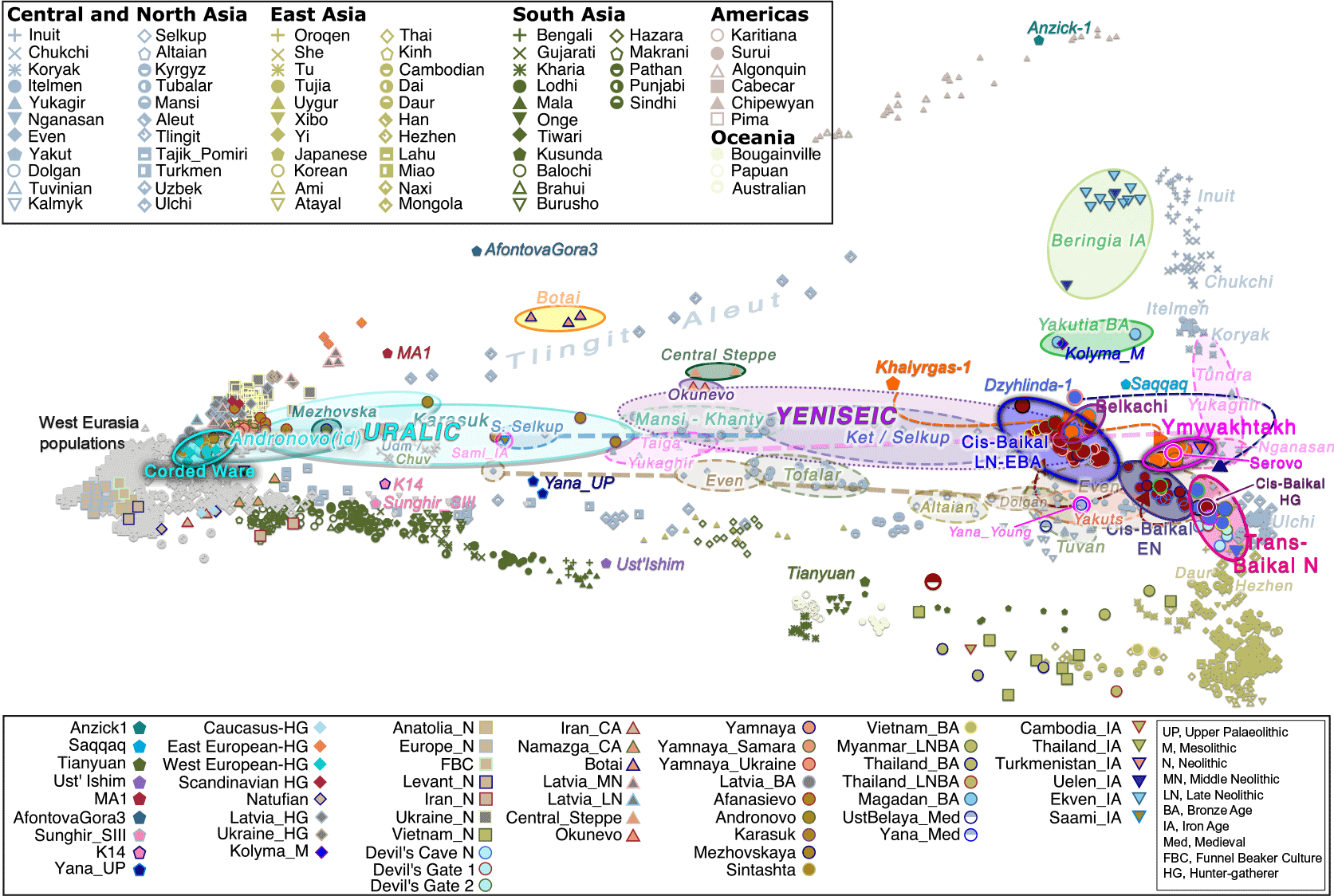
Based on the most reasonable estimates for Proto-Yeniseian and Common Yenisean, and the likely connection of Dene-Yeniseian with Cis-Baikal Neolithic populations, none of those early westward migration waves can correspond to the expansion of the Yeniseic branch. The specific migration or migration waves spreading Yeniseic should be visible in Late Neolithic/Early Bronze Age population movements throughout South and West Siberia, marked by a similar ancestry and increasing Y-DNA bottlenecks, probably under Q1b-L53 lineages (but possibly also including hg. N1a-Tat) from east to west, ultimately stemming from the Circum-Baikal area.
In any case, this migration is unlikely to offer support for the often-cited Seima-Turbino migrationist model of Chernykh & Kuzminykh (1989), because the demographic impact of Corded Ware-related R1a-Z93-rich populations spreading eastward through the Eurasian steppes, forest-steppes and southern taiga during the EBA essentially confirms the archaeological model of an Eastern European origin of materials and elites, stemming ultimately from Fatyanovo-Balanovo and Abashevo populations. Based on the surviving hydronymy, Yeniseic-speaking peoples probably remained still for hundreds or thousands of years (depending on the region) inhabiting the taiga of the Trans-Urals and West and Central Siberia, between the Ural Mountains and the Irtysh, Ob’, and Yenisei river basins.
NOTE. For more on the Seima-Turbino phenomenon and the Andronovo-like Horizon, see below Ob-Ugric Homeland and Proto-Samoyed Homeland.
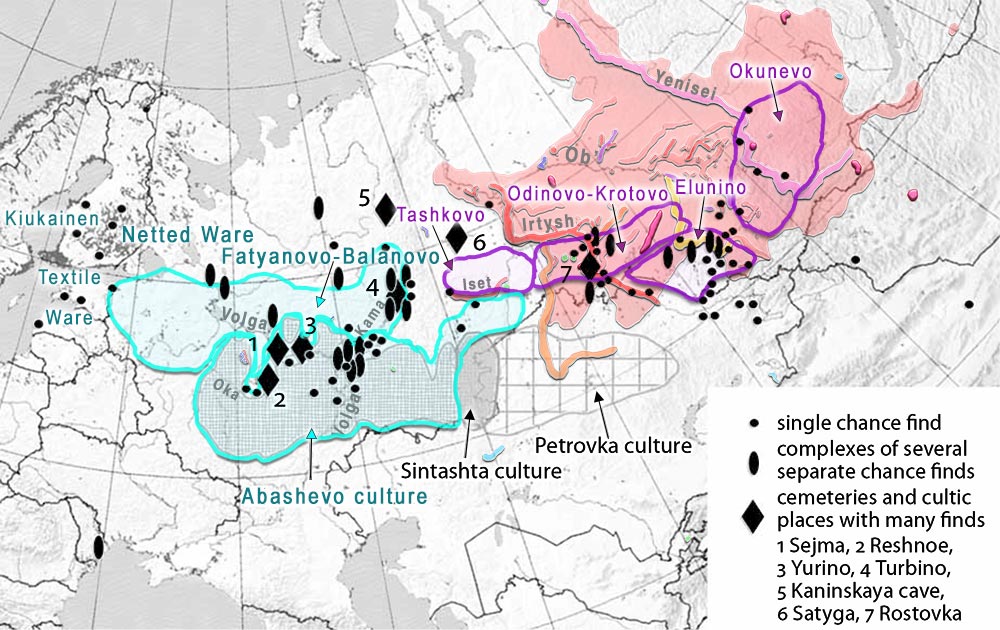
Palaeo-Arctic and Palaeo-Siberian clines
Complicating any simplistic interpretation of modern and ancient east-west and steppe-tundra clines, samples from Okunevo-like cultures are likely to cluster close to the coeval Bolshoy Olenyi Ostrov samples from the Lovozero culture – 2,000-3,000 km to the north-west, and whose N-L1026 haplogroup is (currently) closest to Kra001 from the Serovo Complex in the Kansk-Rubin basin (neighbouring the Minusinsk Basin), and to N4a1 and N4b1 from Ymyyakhtakh (cf. Kılınç et al. 2021). Such northern vs. southern Baikal_N:WSHG clines are not fully unexpected, assuming an admixture of both – Ymyyakhtakh and Okunevo peoples – with more WSHG-like Comb Ware-related groups of the Northern and Southern Trans-Urals, with their Y-DNA bottlenecks stemming ultimately from the Circum-Baikal area.
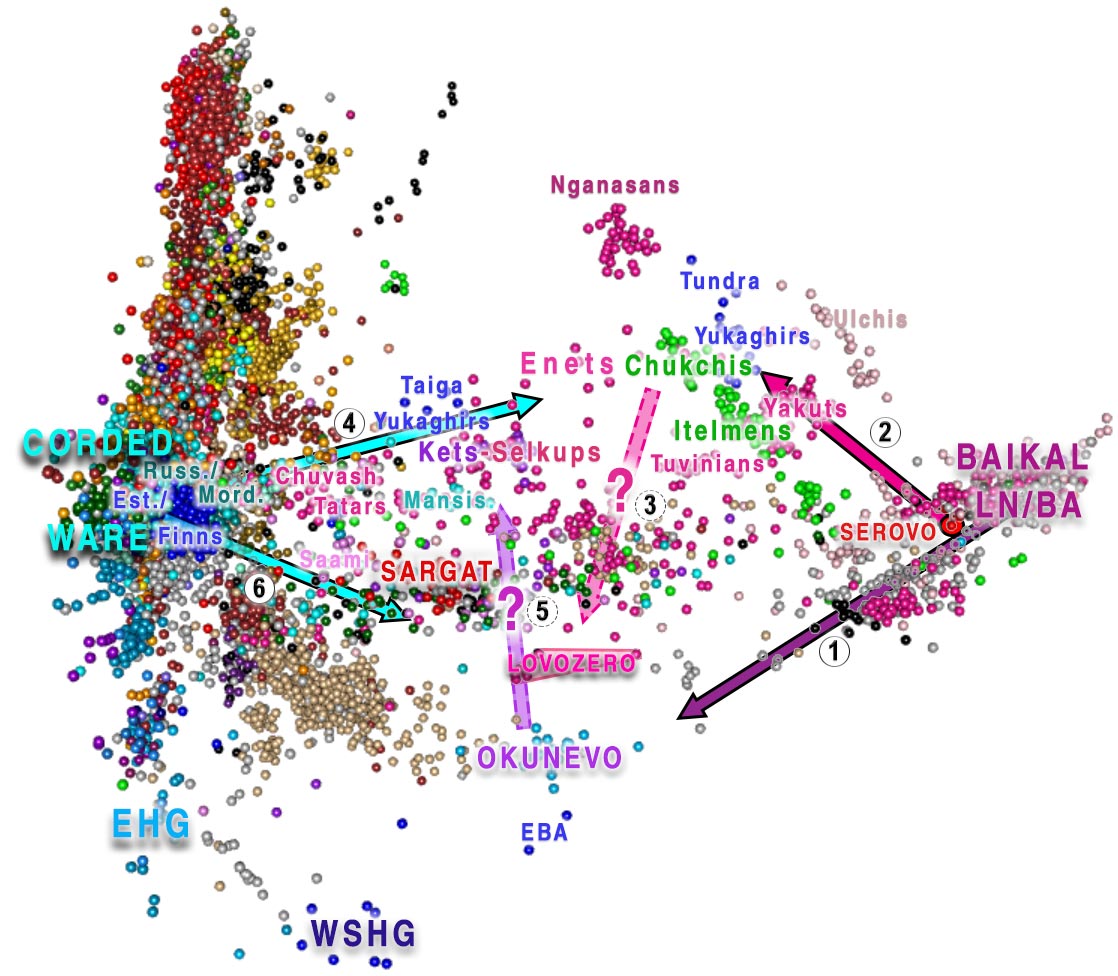
The main problem, however, is that the ancestry of modern Siberians of the Taiga and Tundra – including Ob-Ugrians, Yeniseians, and Taiga Yukaghirs, among others – shows a clear shift toward the Neo-Siberian cline that was formed by the Ymyyakhtakh expansion – including Chukotians, Itelmen, Tundra Yukaghirs, or Enets (who are close to the isolated Nganasans). In other words, modern West Siberian taiga-tundra groups that form the ‘western’ part of the so-called “Siberian” or “Ket-Uralic” ancestry cline do not resemble their potential 4,000-year-old predecessors, who apparently formed two different clines connecting Baikal EBA groups to WSHG-like populations, from Okunevo-related peoples close to the steppes to the Lovozero-related populations around the Barents Sea.
This striking recent convergent shift of both, Arctic and Hypoarctic (N1a-L1026-rich?) and Taiga (Q1b-L330-rich?) populations, is nevertheless restricted to West Siberia. Peoples from North-Eastern Europe – like Estonians, Finns, Northern Russians, and especially Saami – show admixture of Baltic Corded Ware groups with long-isolated Lovozero-like EBA populations, whereas groups like Chuvash, Bashkirs, Tatars, Mari, or Udmurts are apparently within the “Ket-Uralic” cline proper that leads to Enets in the Lower Yenisei.
This strongly suggests that the Central and Northern Urals were, in general, a barrier to gene flow after the EBA, and that the ancestry changes seen in the Cis-Urals are associated with different waves of Late Bronze Age, Iron Age, and medieval nomads expanding westward and admixing with locals from North-Eastern Europe.
NOTE. This isolation and the formation of two clearly distinct Corded Ware-related clines among modern Uralic peoples is the main reason why I thought N1a-Z1934 would have accompanied the northern Palaeo-Laplandic (i.e. Lovozero-related) migration, despite the attested, likely basal N-L1026 lineages from Bolshoy Oleniy Ostrov. Recent findings of N-Z1936 from the Trans-Urals have not clarified this extent much (see below Ob-Ugric Homeland).